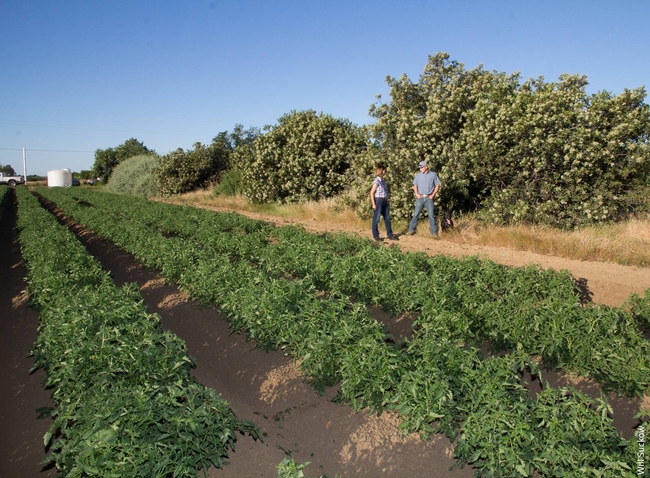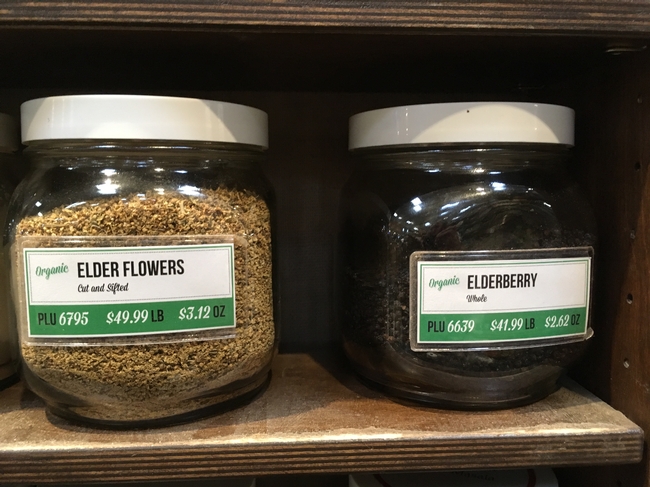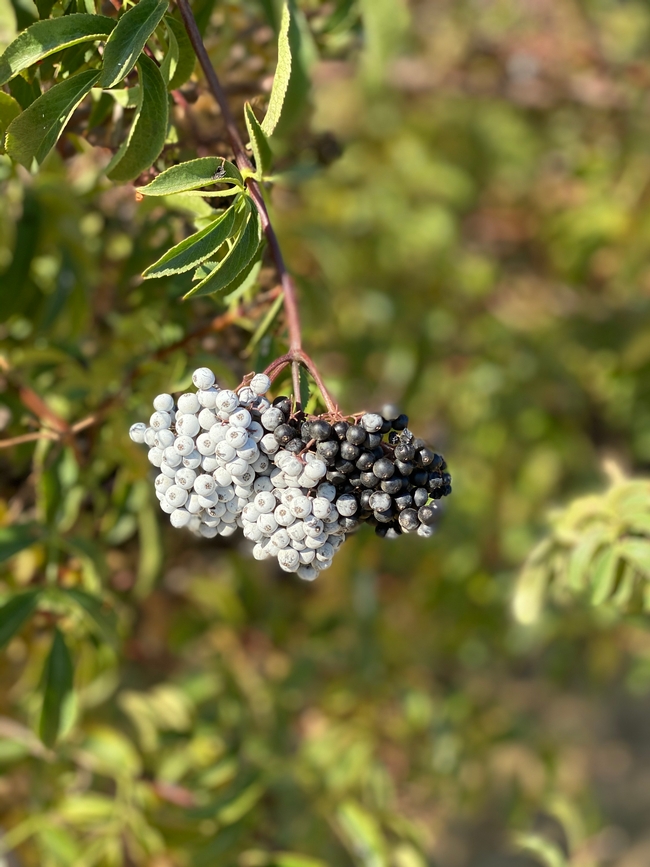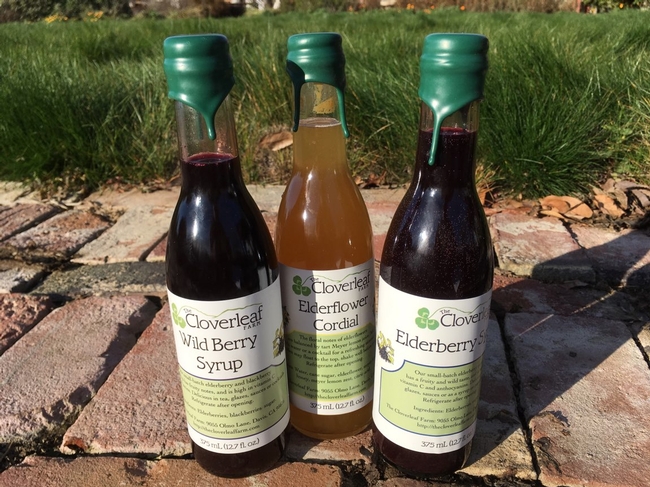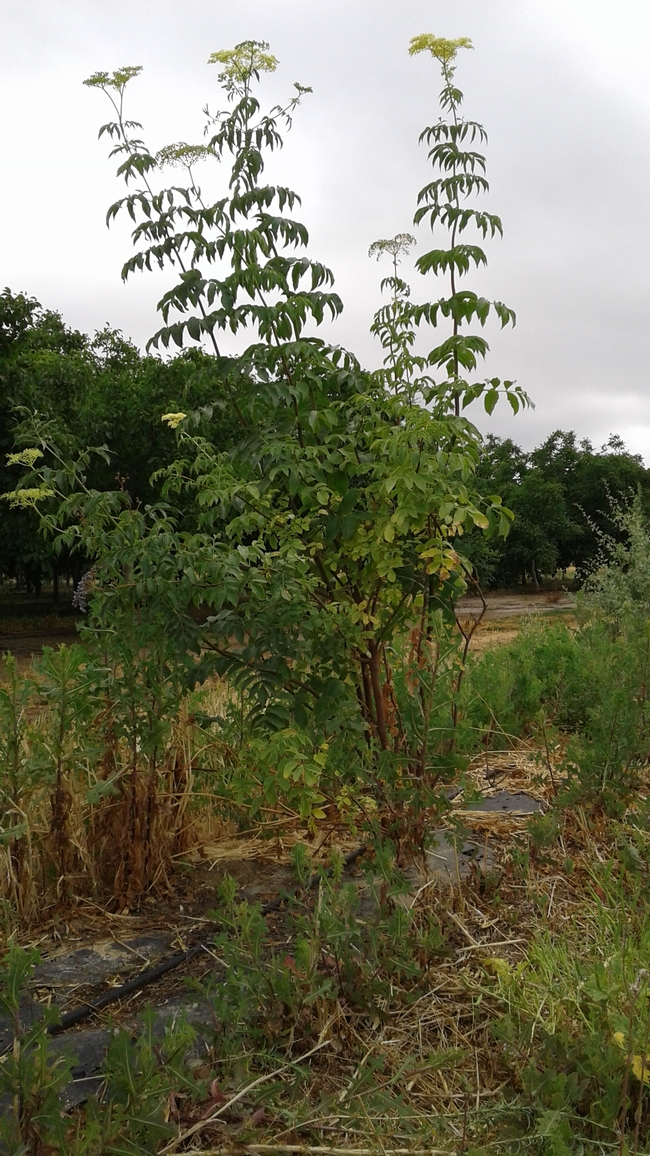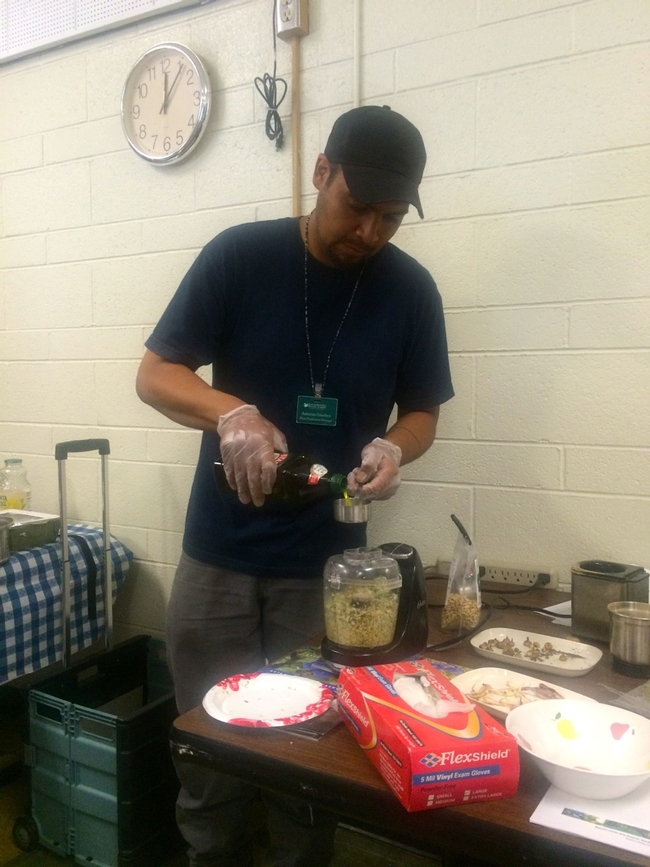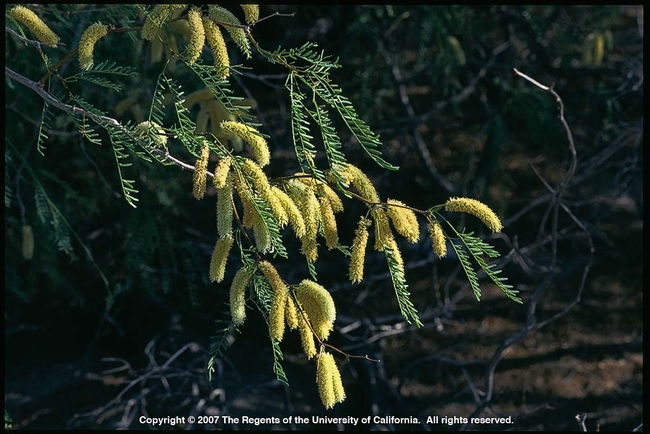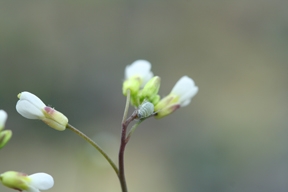Posts Tagged: plants
Growing elderberries in hedgerows adds to farm income, benefits environment
As the sustainability of agriculture continues to be threatened by changes in climate, pests and loss of biodiversity, the ancient practice of planting hedgerows with edible and medicinal species such as elderberry can help growers generate additional revenue while fostering beneficial insects and improving soil health.
Most modern-day farmland is occupied by simple “monocrop” systems that often require frequent, energy-intensive inputs like synthetic fertilizers and pesticides to sustain their yields. These practices can be harmful to water quality, biodiversity and soil health.
But farmers who incorporate perennials into their farm landscapes can better harness living things—crop plants, pollinators, beneficial microbes and natural enemies of pests—to provide services rather than adding synthetic products, to the ultimate benefit of the farm and the environment.
Restoring field edges by planting hedgerows is a common way to add perennials to farm fields without taking land out of production. These managed rows of trees, shrubs, grasses and wildflowers were an ancient feature of agricultural landscapes throughout the world.
As farmland industrialized in Europe and North America in the 1900s, many old hedgerows were removed. But hedgerows have seen a resurgence in recent years as their significant environmental benefits—including natural pest control and pollination services, improved soil health and carbon sequestration—are increasingly recognized.
With hedgerows, “the whole farm can be a site of both conservation and profitability,” says Sonja Brodt, deputy director of the University of California Sustainable Agriculture Research & Education Program (UC SAREP).
Hedgerows can be costly to establish, and this is often the reason farmers choose not to use them. But incorporating a harvestable crop into a hedgerow can be profitable.
Brodt is leading a collaborative effort with California farmers and UC researchers to develop native western elderberry as a hedgerow cash crop. Blue elderberry (Sambucus nigra ssp. cerulea) is a native subspecies of elderberry that is well-adapted to Mediterranean climates and grows prolifically across California. It is thought to be more heat- and drought-tolerant than the more commercialized North American and European subspecies of elderberry.
“Elderberries have this great potential as a ‘win-win' crop. Farmers harvesting and selling elderberries from their hedgerows can receive a direct income from a farm practice that benefits the local ecosystem,” says Brodt.
Consumer demand for elderberry-based products has skyrocketed in recent years. Blue elderberry has similar antioxidant levels to blueberries and can be processed into products such as jams, syrups, tea mixtures and herbal supplements.
“We found that two-thirds of surveyed herbal and specialty foods processors and retailers were strongly interested in sourcing California-grown elderberries and couldn't find enough supply to meet their needs” says Gwenaël Engelskirchen of UC SAREP. Farmers who grow blue elderberry can tap into this growing market.
The research team recently completed a field trial in the southern Sacramento Valley to assess the profitability of blue elderberry. They found that elderberry yields from a 1,000-foot, multispecies hedgerow could provide $2,700 to $4,800 in revenue, after harvest and de-stemming costs, in only the second year after hedgerow planting. This revenue helps offset typical hedgerow establishment costs of $3,000 to $4,000, and elderberry revenue is expected to grow over time as the plant yields continue to increase. Value-added processing and specialty products made on-farm could also increase overall profitability.
While native elderberry hedgerows is a new area of research for the University of California, North America's indigenous people have been harvesting and tending blue elderberry in California for hundreds of years. Many Native persons across the state continue to gather, cultivate and use elderberry.
Sage LaPena, Nomtipom and Tunai Wintu ethnobotanist and certified medical herbalist, stresses that “elderberry is one of our most important traditional medicines and we've never stopped using it.” Cultivating elderberry for harvest could be one path towards increased food sovereignty for California's Native American tribes.
“There's an important lesson with this work,” said Brodt. “While new technologies are valuable for making agriculture more sustainable, we shouldn't lose sight of ancient practices that have benefited humanity and our landscapes over thousands of years. Hedgerows and other biological solutions are an essential piece of the sustainability puzzle. In addition, we have much to learn about the value of our native species from Native peoples and their traditional practices.”
To learn more about this research and to find educational resources for cultivating, processing, and marketing elderberry, visit https://ucanr.edu/sites/Elderberry.
New project seeks to build on the benefits of elderberries
Can plants typically grown for hedgerows also be a source of income? That's the question guiding a new UC study on the potential for farmers to grow elderberries as a commercial crop.
Blue elderberry, a California native plant with clusters of small bluish-black berries and a sweet-tart flavor, have long been eaten by Native Americans in the western states and are used today in jam, syrups, wines and liqueurs. And while elderberry orchards are popping up in parts of the Midwest, California's elderberries are usually just grown on field edges, and elderberry products sold retail rely mostly on foraged crops or imports.
Farmers at The Cloverleaf Farm near Davis are already selling elderberry products from plants grown on their farm, alongside their blackberries and stone fruits. And they find that customers love them. The farmers want to understand the viability of growing elderberries for market beyond their nascent effort, bringing some of the out-of-state production home.
The UC Sustainable Agriculture Research and Education Program (SAREP) launched a project in collaboration with the Cloverleaf Farm, the UC Agriculture Issues Center, UC Davis Department of Food Science and Technology, and four Central Valley farmers to assess the farm management practices, nutritional content, and market potential for elderberry and elderberry products in California.
“I think a lot about the long-term systems sustainability of our food system,” said Katie Fyhrie, one of the farmers at the Cloverleaf. “I keep thinking about how much we focus on production of blackberries and blueberries, when the elderberry also achieves that dark berry color and flavor people like with much fewer resources.”
Elderberries are typically grown on farms as hedgerows for their ability to attract beneficial insects, act as a windbreak, and sequester carbon, benefiting the overall health of the farm, but not providing direct benefit to a farmer's bottom line. Despite long-running federal cost-share programs for planting hedgerows, the number planted in California is still quite small relative to the large expanses of farmland in the state. Adding a financial incentive to planting elderberries may help increase the popularity of hedgerows amongst farmers.
“When we think about building sustainable farming practices, we can think about the whole farm as being a site of both conservation and profitability,” said Sonja Brodt, the project's principal researcher at UC SAREP. “Elderberries may have the potential to combine crop production with environmental conservation functions in a way not typically seen on California farms. This model would enable small- and medium-scale farmers to receive a direct income from a farm practice that benefits the ecosystem as well.”
As climate change impacts California with heat and unpredictable water availability, some studies suggest farmers may need to consider diversifying the crops they grow to adapt to changing local climates.
Elderberries, which grow in arid California regions along the coast and into the mountains, have the potential to grow in a range of climates and adapt to changing California ecosystems in the future.
It is unlikely that farmers would plant entire orchards of elderberries, in part because of restrictions on pruning elderberries that may be home to the Valley elderberry longhorn beetle, a federally threatened species. But for small- and medium-scale growers looking to diversify their income sources, elderberries may provide a boost.
The two-year elderberry project now underway will conclude with a growers' production guide, cost of production study, an assessment of market demand and nutritional contents, and workshops to help link growers with buyers interested in elderberry products. The project will also address issues related to the Valley elderberry longhorn beetle and generating income from hedgerows.
“Elderberry juice is already in so many products,” Fyrhie said, “so building a market for locally grown elderberries seems like a no-lose situation.”
For farmers interested in learning more about incorporating perennials into annual crop farms and similar agroforestry practices, view a webinar on the topic recently hosted by UC SAREP here.
Will edible native plants be a new food trend?
Will edible natives plants be a new food trend, the ultimate in eating locally? Antonio Sanchez at the Rancho Santa Ana Botanic Garden in Claremont hopes so. Among California native plants are many overlooked food sources, some with gourmet potential, according to Sanchez, production manager at the garden. As an added bonus, edible natives are often low-water users that look great in landscapes. He recently gave UC Master Gardeners in Los Angeles County an overview of edible natives, and had them taste some of his favorites, including his recipe for Cleveland Sage Pesto.
There are six native plants that Sanchez thinks are especially worth checking out.
- Miner's lettuce (Claytonia perfoliata). It's easy to grow and found throughout much of California. Its leaves can be used in salad, soup, or pesto. (It can also be a weed in certain situations, according to UC IPM).
- Cleveland sage (Salvia clevelandii). A beautiful, drought tolerant ornamental, it can also be used in pesto, beer, ice cream and baked goods.
- One-leaf onion (Allium unifolium). All parts of this native onion are edible.
- Honey mesquite (Prosopis glandulosa var. torreyana). Dried pods can be ground to make a gluten-free flour.
- Roger's California grape (Vitis ‘Roger's Red'). This plant, which was recently determined to be a hybrid between a native California grape and a cultivated grape, produces small, sweet fruit with seeds that can be eaten fresh, or used for juice or jelly.
- Golden currant (Ribes aureum). Fruit can be eaten fresh or made into jelly.
Adventurous cooks, gardeners, foragers, and anyone else who want to learn about edible native plants can attend the upcoming California Native Food Symposium, which will be held on November 14and 15 at the Rancho Santa Ana Botanic Garden.
The author is Rachel Surls, sustainable food systems advisor for UC Agriculture and Natural Resources Cooperative Extension in Los Angeles County.
Insects, like restaurant customers, shape their wild plant menu
Restaurant patrons with their varied food preferences play a huge role in determining which food items are included on the menu. Now an international team of researchers, including a UC Davis plant scientist, is finding that plant-eating insects do much the same in the natural world, maintaining and shaping the genetic variation of their host plants in a geographic area.
The plant-grazing bugs accomplish this by forcing the plants to create diverse natural defenses to avoid being eaten, which in turn shapes the genetic makeup of the plants in a region. The researchers discovered this by studying aphids and the broccoli-like research plant Arabidopsis thaliana. Their findings provide the first measurable evidence that this selective process is driven, in part, by the pressure that multiple natural enemies exert on plants by forcing them to create diverse natural defenses to avoid being eaten.
“Our data demonstrate that there is a link between the abundance of two types of aphids and the continental distribution of Arabidopsis plants that are genetically different in terms of the biochemicals they produce to defend against insect feeding,” said UC Davis plant scientist Dan Kliebenstein.
His laboratory is examining the naturally occurring chemicals involved with plant defenses to better to understand their role in the environment and to explore their potential for improving human nutrition and fighting cancer.
Ecologists have theorized for decades that genetic change and variation within a plant or animal species is critical to enabling the species to survive changing environmental conditions like the appearance of a new disease or pest.
They have documented that nonbiological changes, such as variations in climate and soil, can exert pressures that cause genetic variation within plant species. However there has been little evidence that biological forces, including insects feeding on plants or competition between plant species, can lead to genetic variation within a plant species across a large geographic area.
In the new study, the researchers first mapped the distribution of six different chemical profiles within Arabidopsis thaliana plants across Europe, each chemical profile controlled by the variation in three genes.
The mapping revealed a change in the function of one of these key genes across geographic areas; the gene changed from southwest to the northeast.
The researchers suspected that two aphid species — Brevicoryne brassicae and Lipaphis erysimi — were the likely causes of the geographic variation. Both are abundant in the regions and feed heavily on Arabidopsis and related plants.
The scientists then tapped data collected by British researchers for nearly 50 years on fluctuations in aphid populations in Europe. They found that distribution of the two aphids species of interest closely mirrored the geographic distribution of the different chemical types of Arabidopsis plants. Like picky restaurant goers, one aphid preferred the southwestern chemical type while the other aphid preferred the northeastern chemical type.
The next step was to determine whether the similarity between the distribution patterns of the plants and the two aphid species was more than coincidental. To do this, the researchers observed what happened when the different aphids fed on five generations of experimentally raised Arabidopsis thaliana plants.
They confirmed that the plants were genetically adapting to the aphids, with each successive plant generation showing less damage from the feeding insects. A change in the genetic makeup of the plant populations specific to each aphid accompanied this trend — and the laboratory plants evolved in a way that tracked the geographic distribution of the two aphids and the plant chemical types.
The researchers also found that when faced with feeding by aphids, the faster-growing Arabidopsis plant types fared better in the laboratory, while the slowest-growing plant types actually went experimentally extinct.
“These data make it clear that even functionally similar plant-eating pests can affect the biochemical and genetic makeup of plant populations, playing a major role in shaping and refining the plant defenses in a natural community,” Kliebenstein said.
You’ll be able to read the complete report on this study, conducted with researchers in Switzerland, Denmark, England and the United States, will appear in the Oct. 5 issue of the journal Science.
Imagine there’s no hunger ... It’s easy if you try
At 925 million, the number of hungry people in the world is unacceptably high.
To combat world hunger, many scientists are working on developing crops that can resist disease and withstand the elements, from drought to floods. One such scientist is Sean Cutler at UC Riverside, whose breakthrough discovery last year of pyrabactin has brought drought-tolerant crops closer to becoming reality and spawned new research in several labs around the world.
Pyrabactin is a synthetic chemical that mimics abscisic acid (ABA), a naturally produced stress hormone in plants that helps them cope with drought conditions by inhibiting growth. ABA has already been commercialized for agricultural use. But it has at least two disadvantages: it is light-sensitive and it is costly to make.
Enter pyrabactin. This chemical is relatively inexpensive, easy to make, and not sensitive to light. But is it free from drawbacks? Unfortunately, no. Unlike ABA, pyrabactin does not turn on all the “receptors” in the plant that need to be activated for drought-tolerance to fully take hold.
What does that mean? A brief lesson on receptors may be in order.
A receptor is a protein molecule in a cell to which mobile signaling molecules – such as ABA or pyrabactin, each of which turns on stress-signaling pathways in plants – may attach. Usually at the top of a signaling pathway, the receptor functions like a boss relaying orders to the team below that then proceeds to execute particular decisions in the cell.
It turns out that each receptor is equipped with a pocket, akin to a padlock, in which a chemical, like pyrabactin, can dock into, operating like a key. Even though the receptor pockets appear to be fairly similar in structure, subtle differences distinguish a pocket from its peers. The result is that while ABA, a product of evolution, can fit neatly in any of these pockets, pyrabactin is less successful. Still, pyrabactin, by being partially effective (it works better on seeds than on plant parts), serves as a leading molecule for devising new chemicals for controlling stress tolerance in plants.
Each receptor is equipped also with a lid that operates like a gate. For the receptor to be activated, the lid must remain closed. Pyrabactin is effective at closing the gate on some receptors, turning them on, but cannot close the gate on others.
Cutler and colleagues have now cracked the molecular basis of this behavior. In a receptor where the gate closes, they have found that pyrabactin fits in snugly to allow the gate to close. In a receptor not activated by pyrabactin, however, the chemical binds in a way that prevents the gate from closing and activating the receptor.
“These insights suggest new strategies for modifying pyrabactin and related compounds so that they fit properly into the pockets of other receptors,” Cutler says. “If a derivative of pyrabactin could be found that is capable of turning on all the receptors for drought tolerance, the implications for agriculture are enormous.”
So he and his colleagues continue their research on pyrabactin derivatives, having set their eyes on the prize: An ABA-mimicking, inexpensive and light-insensitive chemical that can be sprayed easily on corn, soy bean and other crops to help them survive drought – one effective approach to combating and preventing hunger worldwide. Imagine that!


